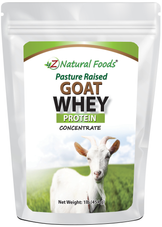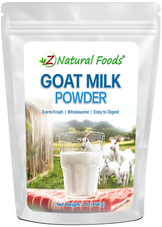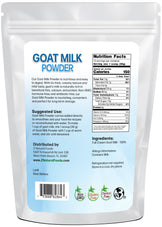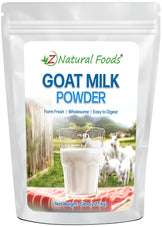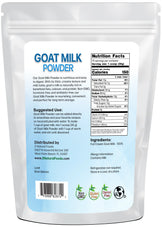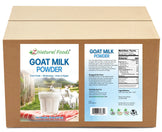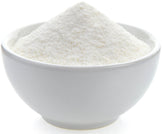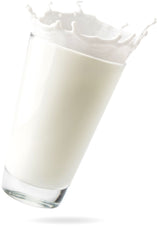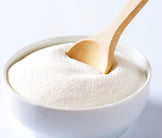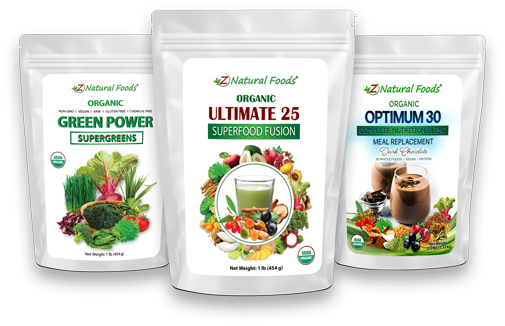Description
Description
Summary
|
Goat Milk Whey Protein: The Insider’s Guide (FAQs Answered)
Z Natural Foods is dedicated to providing customers with a diverse range of high-quality foods in their most versatile forms.
Our Goat Milk Whey protein concentrate powder is a prime example of our commitment to quality.
Today, we aim to answer some of the most frequently asked questions about this versatile product and Goat Milk products in general to ensure you have all the information you need to make informed choices about your natural food and goat milk products.
7 frequently asked questions about our Goat Milk products
1) What is the process for creating a high-quality goat milk whey protein concentrate?
Goat milk whey protein powder is created by collecting farm-fresh goat milk and utilizing old-fashioned and time-tested techniques with modern-day technology to produce a creamy, rich whey concentrate with an 80% protein concentration.
After the milk is collected, it is immediately brought to the processing facility, where a coagulant is added to the milk to create cheese and separate the curds from the whey.
The liquid whey is drained to separate it from the curds and then undergoes a cold filtration process, which filters out any unwanted components.
Finally, using a low-temperature method, the whey is dehydrated, allowing moisture to be removed, and the dehydrated whey is ground into a fine powder to create a smooth texture.
2) Is goat milk whey protein concentrate an undenatured protein?
Goat milk whey protein concentrate is an undenatured protein, which means it retains its original structure and nutritional value. This is important because protein function depends on its structural shape, and heat can cause proteins to vibrate, weakening the bonds that hold their complex shape.
Undenatured proteins, like our goat milk whey protein concentrate, are pure, properly functioning proteins without structural deformation, with all bioavailable nutrients and constituents such as beta-lactoglobulin, alpha-lactalbumin, immunoglobulin, and lactoferrin.
However, it is vital to understand the concept of denatured protein and why it is not necessarily bad.
A protein denatured through cooking with heat or some other process is not necessarily bad because we always eat this form of protein.
For example, a hard-boiled egg is regarded as a form of denatured protein. The heat used to make a hard-boiled egg changes its structural integrity, but it still has excellent nutritional value and all the amino acids to create a complete protein.
3) What is beta-casein, and what is the difference between variants A-1 and A-2?
Casein is the largest group of proteins in milk, making up 80% of the total protein content. A1 and A2 are beta-casein variants.
While they are pretty similar, their primary difference is at position 67 of the amino acid sequence: Histidine for A1 and Proline for A2.
This slight difference can impact digestion. A1 beta-casein is believed to release an opioid peptide (BCM-7) that is considered to be a precursor to various health issues like gut health, heart disease, and diabetes through the increase of systemic inflammation.
A2 beta-casein, on the other hand, does not have this effect, making it a healthier option.
The following was stated in a randomized control trial looking at the effects of milk containing only A2 beta casein versus milk containing both A1 and A2 beta casein proteins on gastrointestinal physiology, symptoms of discomfort, and cognitive behavior of people with self-reported intolerance to traditional cows' milk.
- Compared with milk containing only A2 β-casein, the consumption of milk containing both β-casein types was associated with significantly greater PD3 symptoms;
- Higher concentrations of inflammation-related biomarkers and β-casomorphin-7. Longer gastrointestinal transit times, lower levels of short-chain fatty acids, and increased response time and error rate on the SCIT.
- Consumption of milk containing both β-casein types was associated with worsening PD3 symptoms relative to baseline in lactose-tolerant and lactose-intolerant subjects. Consumption of milk containing only A2 β-casein did not aggravate PD3 symptoms relative to baseline (i.e., after washout of dairy products) in lactose-tolerant and intolerant subjects.
Therefore, it was concluded that “consumption of milk containing A1 β-casein was associated with increased gastrointestinal inflammation, worsening of PD3 symptoms, delayed transit, and decreased cognitive processing speed and accuracy.
Because the elimination of A1 β-casein attenuated these effects, some symptoms of lactose intolerance may stem from the inflammation it triggers and can be avoided by consuming milk containing only the A2 type of beta-casein.
4) Why do goat milk products have a different flavor profile than cow milk products?
While various factors may affect its taste, fresh goat milk generally has a flavor profile similar to that of cow milk. It is rich, creamy, and slightly sweet. However, products made from goat milk are known to have a slightly more tart and gamey flavor profile. There are many reasons for this phenomenon.
- A goat's diet can significantly impact the taste of its milk. Goats grazing on diverse pastures will produce a different flavor profile from goats that are solely fed hay.
- Different breeds of goats can produce various tasting milk.
- The goat's health is also a contributing factor to the taste of its milk. A common condition called mastitis (inflammation of the udder) causes a chemical and physical reaction in the milk.
- Finally, goat milk has a higher proportion of short-chained fatty acids than cow milk, which may contribute to its flavor profile. As the milk ages to make goat milk products, the fatty acids Caproic, Capric, and Caprylic acids seem to be the contributing factor for the pronounced flavor.
5) How do goat milk products affect our gut health and microbiome?
It is well known that goat milk products are well tolerated by those who can’t tolerate cows milk products. We also know one of the primary reasons (as we discussed earlier) is due to the specific form of casein and digestible form of fats found in goat milk products. However, one topic not often discussed is how goat milk products affect the microbiome.
According to the National Institute of Environmental Health Sciences, the microbiome is the collection of all microbes (bacteria, fungi, and viruses) and their genes that naturally live on and inside our bodies.
The human gut microbiome contains more than ten trillion microorganisms with more than 1000 species of known bacteria.
One primary aspect is the prebiotic compounds found in goat milk products. Prebiotics are identified based on the composition of their fiber content. Like other milks, goat milk contains probiotics but is also a quality source of prebiotic oligosaccharides that help feed the gut bacteria. In simple terms, oligosaccharides are a carbohydrate chain comprising 3-10 simple sugar molecules.
For example, sucrose comprises the two simple sugars, fructose and glucose. However, there are many types of oligosaccharides, and some of them include the following.
- Fructooligosaccharides(FOS)
- Galactooligosaccharides(GOS)
- Gluco-oligosaccharides
- Arabinooligosaccharides (AOS)
The following was stated in a paper discussing comparing functional properties between human and goat milk oligosaccharides.
- Goat milk contains significantly more oligosaccharides (gMOS) than bovine (bMOS) or sheep (sMOS) milk and also has a more considerable diversity of structures.
- Quantitative studies of goat milk oligosaccharides range from 60 to 350 mg/L in mature milk and from 200 to 650 mg/L in colostrum. These levels are clearly lower than in human milk (5–20 g/L) but higher than in other domesticated dairy animals, e.g., bovine (30–60 mg/L) and sheep (20–40 mg/L)
- Some studies have shown anti-inflammatory effects of mixtures enriched in gMOS.
- Goat MOS also displays prebiotic potential, particularly in preferentially stimulating bifidobacteria growth.
6) Why is goat whey protein (or whey protein in general) considered such a spectacular food?
To understand why whey protein is such a fantastic food, we need to examine protein synthesis and the role of the amino acid L-leucine in this process. In simple terms, protein synthesis is the process by which cells make protein by assembling amino acids and bonding them into specific polypeptide sequences.
This process occurs in two stages: transcription (Copying DNA into RNA) and translation (Using RNA to make protein). Once the polypeptide chain is synthesized, it forms the finished protein.
So, how does the amino acid L-leucine play a role in this essential process? Whey protein is the highest biological source of this essential amino acid. Furthermore, Leucine has been reported to increase protein synthesis by increasing the phosphorylation of proteins involved in the mTOR signaling pathway, a key regulator of cell growth and metabolism.
Phosphorylation is critical in regulating cell cycle, growth, and apoptosis. mTOR also regulates cell proliferation, autophagy, and apoptosis. However, much like inflammation, with mTOR, balance is the key, as too much or too little can potentially cause various health issues.
The following was stated in a preliminary study looking at the protective qualities of sheep/goat whey protein in preventing the overactivation of mTOR in rats.
- The results showed a decrease in the levels of essential and branched-chain amino acids in the experimental group.
- p70-S6K1 expression was decreased in the liver of rats that consumed whey protein.
Therefore, the following was concluded. “The reduction of amino acid levels and the concomitant inactivation of mTOR implies that whey could potentially act protectively against disorders induced by mTOR overactivation.”
7) What are the best ways to mask goat whey protein's “tart and gamey” flavor?
For starters, there is no perfect method for completely masking the flavor of goat whey protein. Therefore, it is best to use ingredients that will “smooth out” the flavor profile. Simple choices like bananas, berries, and nut butters effectively take the edge off.
However, when we look at traditional flavoring pairings with goat milk products like cheese, honey is at the top of the list. Honey is an excellent choice because there are many varieties and flavor profiles based on the flower where the bee pollinated. Therefore, this gives you a variety of options to choose from and experiment with.
In conclusion, it should be no surprise that around 75% of the milk used worldwide comes from goats. For many people, goat milk is more easily digestible, has 13% less lactose, and does not create the phlegm reaction commonly seen in cow's milk. I hope we have clarified the confusion on this topic and answered all of your frequently asked questions.
For more information about our Goat Whey Protein Concentrate, go here: Goat Whey Protein Concentrate
For more information about our Goat Milk Powder, go here: Goat Milk Powder
About Michael Stuchiner, Master Herbalist
Michael Stuchiner is a Master Herbalist and proud graduate of The School of Natural Healing and has worked in different areas of this field for over 25 years. He is a retired elite-level powerlifter who competed for 27 years. As an avid international traveler, he is passionate about the use of medicinal and tonic herbs, as well as foods traditionally found in local markets in the 35 countries he has visited. Michael brings you his years of experience as a Master Herbalist, traveler, and athlete through the hundreds of articles he has written and his YouTube channel (A Master Herbalist Perspective). He is considered a true educator in this field. For more articles written by Mike, go here: Master Herbalist.



